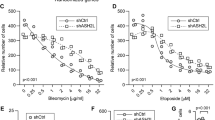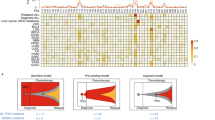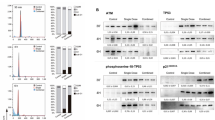Abstract
Mantle cell lymphomas (MCL) are characterized by their aggressive behavior and poor response to chemotherapy regimens. We report here evidence of increased in vitro radiation sensitivity in two cell lines that we have generated from two MCL patients (UPN1 and UPN2). However, despite their increased radiation sensitivity, UPN2 cells were totally resistant to apoptotic cell death, whereas UPN1 cells underwent massive apoptosis 6 h after irradiation. The frequency of induced chromosomal abnormalities was higher in UPN1 as compared to UPN2. Distinct mechanisms have been found to contribute to this phenotype: a major telomere shortening (UPN1 and UPN2), deletion of one ATM allele and a point mutation in the remaining allele in UPN2, mutation of p53 gene (UPN1 and UPN2) with absence of functional p53 as revealed by functional yeast assays. After irradiation, Ku70 levels in UPN1 increased and decreased in UPN2, whereas in the same conditions, DNA-PKcs protein levels decreased in UPN1 and remained unchanged in UPN2. Thus, irradiation-induced apoptotic cell death can occur despite the nonfunctional status of p53 (UPN1), suggesting activation of a unique pathway in MCL cells for the induction of this event. Overall, our study demonstrates that MCL cells show increased radiation sensitivity, which can be the result of distinct molecular events. These findings could clinically be exploited to increase the dismal response rates of MCL patients to the current chemotherapy regimens.
This is a preview of subscription content, access via your institution
Access options
Subscribe to this journal
Receive 50 print issues and online access
$259.00 per year
only $5.18 per issue
Buy this article
- Purchase on Springer Link
- Instant access to full article PDF
Prices may be subject to local taxes which are calculated during checkout






Similar content being viewed by others
References
Ahmed S and Hodgkin J . (2000). Nature, 403, 159–164.
Banin S, Moyal L, Shieh S, Taya Y, Anderson CW, Chessa L, Smorodinsky NI, Prives C, Reiss Y, Shiloh Y and Ziv Y . (1998). Science, 281, 1674–1677.
Baskaran R, Wood LD, Whitaker LL, Canman CE, Morgan SE, Xu Y, Barlow C, Baltimore D, Wynshaw-Boris A, Kastan MB and Wang JY . (1997). Nature, 387, 516–519.
Behr TM, Griesinger F, Riggert J, Gratz S, Behe M, Kaufmann CC, Wormann B, Brittinger G and Becker W . (2002). Cancer, 94, 1363–1372.
Bodrug SE, Warner BJ, Bath ML, Lindeman GJ, Harris AW and Adams JM . (1994). EMBO J., 13, 2124–2130.
Bosch F, Jares P, Campo E, Lopez-Guillermo A, Piris MA, Villamor N, Tassies D, Jaffe ES, Montserrat E and Rozman C . (1994). Blood, 84, 2726–2732.
Brown KD, Barlow C and Wynshaw-Boris A . (1999). Am. J. Hum. Genet., 64, 46–50.
Camacho E, Hernandez L, Hernandez S, Tort F, Bellosillo B, Bea S, Bosch F, Montserrat E, Cardesa A, Fernandez PL and Campo E . (2002). Blood, 99, 238–244.
Campo E, Raffeld M and Jaffe ES . (1999). Semin. Hematol., 36, 115–127.
Canman CE, Lim DS, Cimprich KA, Taya Y, Tamai K, Sakaguchi K, Appella E, Kastan MB and Siliciano JD . (1998). Science, 281, 1677–1679.
d'Adda di Fagagna F, Hande MP, Tong WM, Lansdorp PM, Wang ZQ and Jackson SP . (1999). Nat. Genet., 23, 76–80.
Dreyling MH, Bullinger L, Ott G, Stilgenbauer S, Muller-Hermelink HK, Bentz M, Hiddemann W and Dohner H . (1997). Cancer Res., 57, 4608–4614.
Flaman JM, Frebourg T, Moreau V, Charbonnier F, Martin C, Chappuis P, Sappino AP, Limacher IM, Bron L, Benhattar J, Tada M, Van Meir EG, Esteicher A and Iggo RD . (1995). Proc. Natl. Acad. Sci. USA, 92, 3963–3967.
Gatei M, Scott SP, Filippovitch I, Soronika N, Lavin MF, Weber B and Khanna KK . (2000). Cancer Res., 60, 3299–3304.
Gately DP, Hittle JC, Chan GK and Yen TJ . (1998). Mol. Biol. Cell, 9, 2361–2374.
Gilley D, Tanaka H, Hande MP, Kurimasa A, Li GC, Oshimura M and Chen DJ . (2001). Proc. Natl. Acad. Sci. USA, 98, 15084–15088.
Gopal AK, Rajendran JG, Petersdorf SH, Maloney DG, Eary JF, Wood BL, Gooley TA, Bush SA, Durack LD, Martin PJ, Matthews DC, Appelbaum FR, Bernstein ID and Press OW . (2002). Blood, 99, 3158–3162.
Hou M, Xu D, Bjorkholm M and Gruber A . (2001). Clin. Chem., 47, 519–524.
Iavarone A and Massague J . (1997). Nature, 387, 417–422.
Khanna KK, Keating KE, Kozlov S, Scott S, Gatei M, Hobson K, Taya Y, Gabrielli B, Chan D, Lees-Miller SP and Lavin MF . (1998). Nat. Genet., 20, 398–400.
Lavin MF, Khanna KK, Beamish H, Spring K, Watters D and Shiloh Y . (1995). Trends Biochem. Sci., 20, 382–383.
Lovec H, Grzeschiczek A, Kowalski MB and Moroy T . (1994). EMBO J., 13, 3487–3495.
M'kacher R, Farace F, Bennaceur A, Violot D, Clausse B, Dossou J, Valent A, Parmentier C, Ribrag V, Bosq J, Carde P, Turhan AG and Bernheim A . (2003). Cancer Genet. Cytogenet., 142, 32–38.
Metcalfe JA, Parkhill J, Campbell L, Stacey M, Biggs P, Byrd PJ and Taylor AM . (1996). Nat. Genet., 13, 350–353.
Meyer KM, Hess SM, Tlsty TD and Leadon SA . (1999). Oncogene, 18, 5795–5805.
Pandita TK . (2002). Oncogene, 21, 611–618.
Pandita TK, Westphal CH, Anger M, Sawant SG, Geard CR, Pandita RK and Scherthan H . (1999). Mol. Cell. Biol., 19, 5096–5105.
Rotman G and Shiloh Y . (1998). Hum. Mol. Genet., 7, 1555–1563.
Savitsky K, Bar-Shira A, Gilad S, Rotman G, Ziv Y, Vanagaite L, Tagle DA, Smith S and Uziel T and Sfez S . et al. (1995). Science, 268, 1749–1753.
Schaffner C, Idler I, Stilgenbauer S, Dohner H and Lichter P . (2000). Proc. Natl. Acad. Sci. USA, 97, 2773–2778.
Shafman T, Khanna KK, Kedar P, Spring K, Kozlov S, Yen T, Hobson K, Gatei M, Zhang N, Watters D, Egerton M, Shiloh Y, Kharbanda S, Kufe D and Lavin MF . (1997). Nature, 387, 520–523.
Smilenov LB, Dhar S, Pandita TK . (1999). Mol. Cell Biol., 19, 6963–6971.
Stankovic T, Weber P, Stewart G, Bedenham T, Murray J, Byrd PJ, Moss PA and Taylor AM . (1999). Lancet, 353, 26–29.
Tolksdorf G, Stein H and Lennert K . (1980). Br. J. Cancer, 41, 168–182.
Verpy E, Biasotto M, Meo T and Tosi M . (1994). Proc. Natl. Acad. Sci. USA, 91, 1873–1877.
Vorechovsky I, Luo L, Dyer MJ, Catovsky D, Amlot PL, Yaxley JC, Foroni L, Hammarstrom L, Webster AD and Yuille MA . (1997). Nat. Genet, 17, 96–99.
Weisenburger DD and Armitage JO . (1996). Blood, 87, 4483–4494.
Zakian VA . (1995). Science, 270, 1601–1607.
Acknowledgements
We thank Pr H de Thé (Laboratoire de biochimie B, Hopital Saint-Louis, Paris) for p53 investigation, Dr N Andersen (Department of Hematology, Copenhagen, Denmark) for providing MCL cell lines (Granta and NCE) and Dr M Gueret-Amor for providing AT cell line. We also thank ML Bonnet and M Guillier for their excellent technical help.
Author information
Authors and Affiliations
Corresponding author
Rights and permissions
About this article
Cite this article
M'kacher, R., Bennaceur, A., Farace, F. et al. Multiple molecular mechanisms contribute to radiation sensitivity in mantle cell lymphoma. Oncogene 22, 7905–7912 (2003). https://doi.org/10.1038/sj.onc.1206826
Received:
Revised:
Accepted:
Published:
Issue Date:
DOI: https://doi.org/10.1038/sj.onc.1206826
Keywords
This article is cited by
-
Effectiveness and tolerability of first-line autologous stem cell transplant and maintenance rituximab for mantle cell lymphoma
Bone Marrow Transplantation (2018)
-
Measles Virus Entry Through the Signaling Lymphocyte Activation Molecule Governs Efficacy of Mantle Cell Lymphoma Radiovirotherapy
Molecular Therapy (2013)
-
Peripheral blood complete remission after splenic irradiation in Mantle-Cell Lymphoma with 11q22-23 deletion and ATM inactivation
Radiation Oncology (2006)
-
Activation of mitochondrial apoptotic pathway in mantle cell lymphoma: high sensitivity to mitoxantrone in cases with functional DNA-damage response genes
Oncogene (2004)



